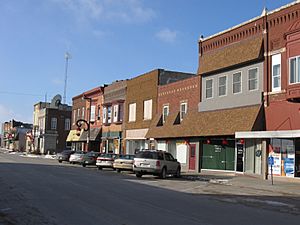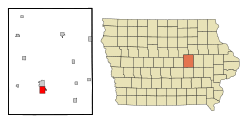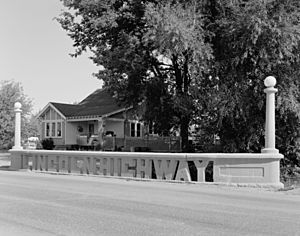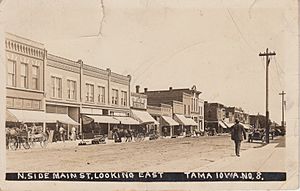Tama, Iowa facts for kids
Quick facts for kids
Tama, Iowa
|
|
|---|---|

Tama, Iowa
|
|

Location of Tama, Iowa
|
|
| Country | |
| State | |
| County | Tama |
| Area | |
| • Total | 3.12 sq mi (8.07 km2) |
| • Land | 2.97 sq mi (7.70 km2) |
| • Water | 0.15 sq mi (0.38 km2) |
| Elevation | 840 ft (256 m) |
| Population
(2020)
|
|
| • Total | 3,130 |
| • Density | 1,053.52/sq mi (406.74/km2) |
| Time zone | UTC-6 (Central (CST)) |
| • Summer (DST) | UTC-5 (CDT) |
| ZIP code |
52339
|
| Area code(s) | 641 |
| FIPS code | 19-77115 |
| GNIS feature ID | 0462174 |
Tama is a city in Tama County, Iowa, United States. The population was 3,130 at the time of the 2020 census.
Tama is situated two miles south of Toledo, the county seat. The two towns are close enough to have nearly grown together over the years.
Contents
History
Tama got its start in the year 1862, following construction of the Cedar Rapids and Missouri River Railroad through the territory.
Tama is located a few miles from the Meskwaki Settlement, Iowa's only significant Native American community. Tama was located on the historic Lincoln Highway and is home to an original Lincoln Highway bridge, listed on the National Register of Historic Places. Tama is named for Taimah, the 19th century Meskwaki leader.
Geography

According to the United States Census Bureau, the city has a total area of 3.41 square miles (8.8 km2), of which 3.26 square miles (8.4 km2) is land and 0.15 square miles (0.39 km2) is water.
Demographics
| Historical populations | ||
|---|---|---|
| Year | Pop. | ±% |
| 1870 | 1,161 | — |
| 1880 | 1,289 | +11.0% |
| 1890 | 1,741 | +35.1% |
| 1900 | 2,649 | +52.2% |
| 1910 | 2,290 | −13.6% |
| 1920 | 2,601 | +13.6% |
| 1930 | 2,626 | +1.0% |
| 1940 | 2,832 | +7.8% |
| 1950 | 2,930 | +3.5% |
| 1960 | 2,925 | −0.2% |
| 1970 | 3,000 | +2.6% |
| 1980 | 2,968 | −1.1% |
| 1990 | 2,697 | −9.1% |
| 2000 | 2,731 | +1.3% |
| 2010 | 2,877 | +5.3% |
| 2020 | 3,130 | +8.8% |
| Source: and Iowa Data Center Source: |
||
2020 census
As of the census of 2020, there were 3,130 people, 1,118 households, and 716 families residing in the city. The population density was 1,053.4 inhabitants per square mile (406.7/km2). There were 1,243 housing units at an average density of 418.3 per square mile (161.5/km2). The racial makeup of the city was 64.3% White, 1.5% Black or African American, 6.7% Native American, 0.5% Asian, 0.0% Pacific Islander, 14.0% from other races and 12.9% from two or more races. Hispanic or Latino persons of any race comprised 31.3% of the population.
Of the 1,118 households, 35.2% of which had children under the age of 18 living with them, 43.2% were married couples living together, 9.4% were cohabitating couples, 27.8% had a female householder with no spouse or partner present and 19.6% had a male householder with no spouse or partner present. 36.0% of all households were non-families. 30.0% of all households were made up of individuals, 14.0% had someone living alone who was 65 years old or older.
The median age in the city was 35.2 years. 30.3% of the residents were under the age of 20; 6.8% were between the ages of 20 and 24; 25.8% were from 25 and 44; 21.4% were from 45 and 64; and 15.7% were 65 years of age or older. The gender makeup of the city was 48.7% male and 51.3% female.
2010 census
As of the census of 2010, there were 2,877 people, 1,092 households, and 708 families living in the city. The population density was 882.5 inhabitants per square mile (340.7/km2). There were 1,234 housing units at an average density of 378.5 per square mile (146.1/km2). The racial makeup of the city was 78.4% White, 0.5% African American, 5.8% Native American, 0.3% Asian, 9.7% from other races, and 5.2% from two or more races. Hispanic or Latino of any race were 23.6% of the population.
There were 1,092 households, of which 36.5% had children under the age of 18 living with them, 47.9% were married couples living together, 11.6% had a female householder with no husband present, 5.3% had a male householder with no wife present, and 35.2% were non-families. 29.0% of all households were made up of individuals, and 15.2% had someone living alone who was 65 years of age or older. The average household size was 2.58 and the average family size was 3.21.
The median age in the city was 35.6 years. 28.7% of residents were under the age of 18; 8.6% were between the ages of 18 and 24; 24.5% were from 25 to 44; 22.3% were from 45 to 64; and 16.1% were 65 years of age or older. The gender makeup of the city was 48.7% male and 51.3% female.
Healthcare
Tama-Toledo area residents have access to healthcare services at MercyCare Tama or Unity Point Toledo Clinic. When hospitalization is required the closest and most convenient hospital for residents is Grinnell Regional Medical Center or UnityPoint Health - Marshalltown Hospital.
Education
It is within the South Tama County Community School District.
Notable people
- Vivia Belle Appleton, physician, medical missionary
- Paul Bradley, retired MMA fighter
- Lance Horbach, member of the Iowa House of Representatives
- Andre Roberts, retired MMA fighter
- Bob Soth, long-distance runner who competed in the 1960 Summer Olympics
- Ska-ba-quay Tesson, Meskwaki artist
- Lewis Haines Wentz, businessman
See also
 In Spanish: Tama (Iowa) para niños
In Spanish: Tama (Iowa) para niños


